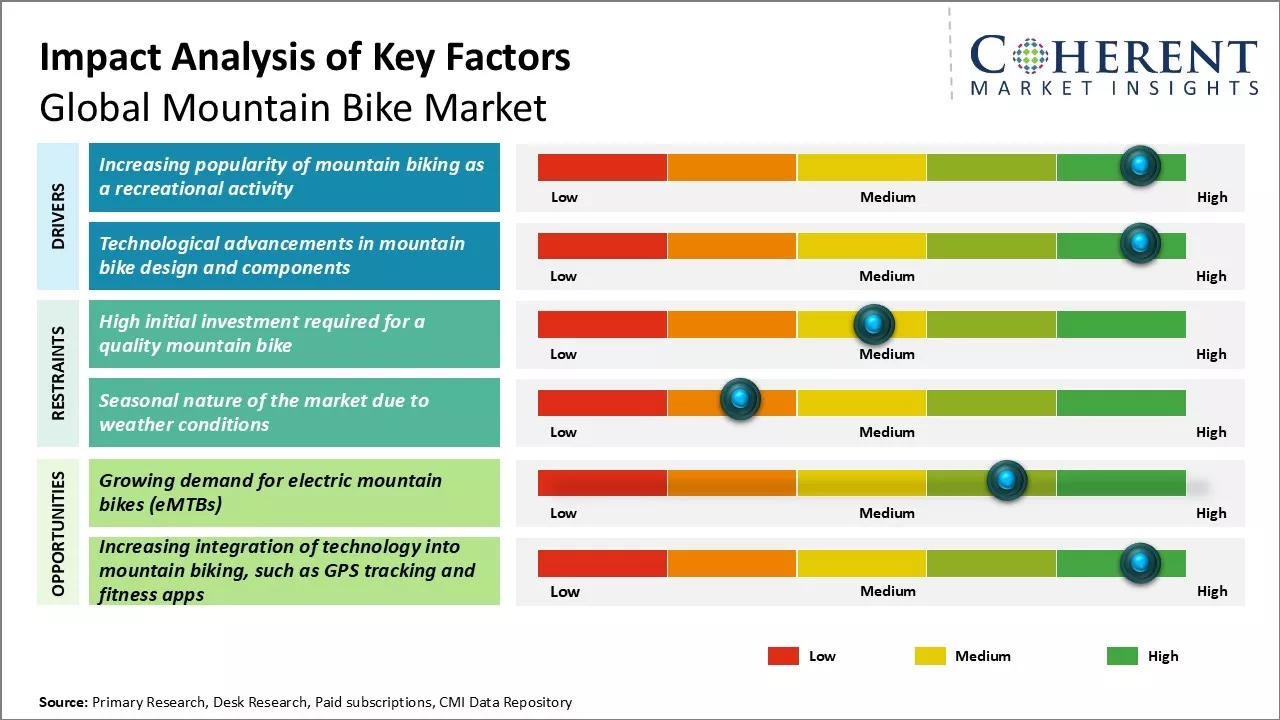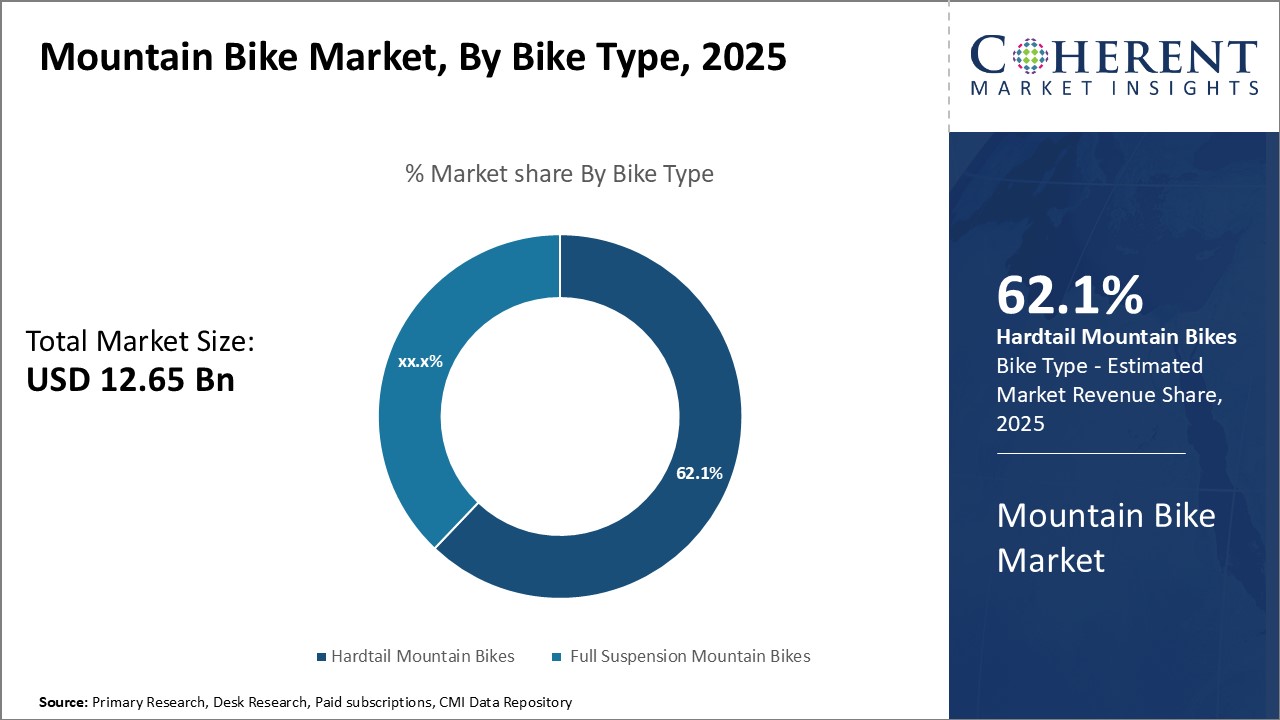The Global Mountain Bike Market is estimated to be valued at US$ 12.65 Billion in 2025 and is expected to reach US$ 25.96 Billion by 2032, exhibiting a compound annual growth rate (CAGR) of 10.8% from 2025 to 2032.

Discover market dynamics shaping the industry: Request sample copy
Factors such as growing adventure and recreational activities, increasing health consciousness, rising disposable income, and improving cycling infrastructure have been driving the sales of mountain bikes across regions. Moreover, continuous product innovations including features such as lightweight alloy frames, multiple gear systems, front and rear suspension for comfortable ride on uneven terrains have been augmenting the popularity of mountain biking as sport. Leading manufacturers have also been focusing on electric mountain bikes to attract more customers. However, high costs associated may continue to remain a key challenge for the widespread adoption of mountain bikes globally over the forecast period.
Increasing popularity of mountain biking as a recreational activity
Mountain biking has grown tremendously in popularity as a recreational activity over the past decade. Rather than just being a niche sport, riding off-road trails has increasingly become a mainstream hobby that people from all ages and backgrounds are taking up. This increasing interest in mountain biking as a fun physical activity that individuals and families can enjoy together is a major driver behind the expanded market for mountain bikes.
Mountain biking events and competitions also continue to attract massive spectator audiences. Major competitions broadcast on television showcase the actions and skills of pro athletes hurtling down steep downhill courses or navigating technical obstacle sections. Witnessing these performances further inspires others to take up the sport. In addition, bike manufacturers and retailers have effectively marketed lifestyle brands centered around mountain biking. The promotion of mountain biking as a cool, edgy activity by leading bike brands has contributed to growing its "action sport" image and reception among younger demographics.

Get actionable strategies to beat competition: Request sample copy
Technological advancements in mountain bike design and components
Constant improvements in mountain bike engineering and the integration of new materials have revolutionized bike performance capabilities. Advanced full suspension designs provide supreme comfort and handling over rough terrain. Wider range gears and more durable drivetrains better tackle any incline or terrain. Impressive braking power from hydraulic disc brakes installed on nearly all models has enhanced control and safety.
Carbon fiber and aluminum alloy frame materials have created bikes that are both remarkably lightweight as well as robust enough to withstand crashes. Wide-range 1x drivetrains with fewer gears reduce complexity while covering all conditions. In addition, progressive suspension systems with multiple points of adjustment offer customizable abilities to suit a wide range of trails and riding styles. E-bikes are also an emerging subset that utilize small electric motors with pedal-assist functions to take mountain biking to new altitudes.
At the component level, continuous upgrades in wheel, tire, and saddle technologies also boost riding enjoyment and functionality. Wider rim and tire profiles coupled with lower pressures provide more traction and float over surfaces. Innovations like electronic shifting permit clutch-like gear changes with the push of a button. Even smartphone app integration allows for remote suspension adjustments and bike tracking features. All of these cutting-edge technologies serve to heighten the mountain biking experience, fueling greater interest and more frequent purchasing of the latest high-performance models.
Key Takeaways from Analyst:
The increasing popularity of outdoor recreational activities and adventure sports is a key driver boosting demand for mountain bikes globally. Rising health awareness among consumers and their inclination towards active lifestyles is another factor supporting the adoption of mountain biking as a fitness activity.
North America currently dominates the global market due to growing mountain biking tourism and the presence of major brands in the region. However, Europe is also emerging as a major market given the large number of mountain trails and cycling infrastructure being developed across various countries. Asia Pacific is likely to be the fastest growing regional market. This can be attributed to rising consumer incomes, growing health consciousness, and increasing government investments in developing cycling tracks in countries like India and China.
High procurement and maintenance costs of mountain bikes act as a restraint on the market to some extent. Another challenge is the seasonal nature of mountain biking which is dependent on weather conditions. Any excessive rainfall or snowfall can negatively impact sales during those periods. Lack of sufficient trails and cycling infrastructure in many developing markets also hinders market expansion.
To strengthen their market position, companies are innovating their product offerings and incorporating modern technologies like electric drives and advanced suspensions.
Market Challenges: High initial investment required for a quality mountain bike
One of the key challenges faced by the global mountain bike market is the high initial investment required to purchase a quality mountain bike. Mountain bikes designed for off-road trails and rough terrains are built with high quality durable frames and components to withstand rugged use. This makes the production of mountain bikes a capital-intensive process. As a result, most reputed mountain bike brands price their premium full suspension bikes between US$3000 and US$6000. This high entry cost prevents casual riders and bike enthusiasts with a limited budget from experiencing the thrill of mountain biking. Additionally, frequent replacement and repairs of worn-out components like shocks, gears and brakes further add to the ownership cost over the years. Unless financing or rental options are made available, the niche audience of professional mountain bikers alone may not be enough to drive higher sales volumes for manufacturers.
Market Opportunities: Growing Demand for Electric Mountain Bikes (eMTBs)
One major opportunity for the global mountain bike market is the growing popularity and demand for electric mountain bikes. eMTBs address one of the key barriers to mass adoption which is the strenuous physical effort and fitness required for mountain biking on steep terrains. With pedal assist powered by a rechargeable battery and electric motor, eMTBs enable riders of varying fitness levels to traverse more difficult trails with less exertion. This has led to a massive surge in their sales across North America and Europe in recent years. In fact, the eMTB segment is projected to become the fastest growing category within the overall mountain bike industry. Their increasing use both for recreational riding as well as urban commuting indicates huge future potential. Manufacturers are investing heavily in eMTB innovation to cater to this untapped demand base seeking an electric alternative to traditional mountain bikes.

Discover high revenue pocket segments and roadmap to it: Request sample copy
Insights By Bike Type - Unmatched Durability and Affordability Drive popularity of Hardtail Mountain Bikes
In terms of Bike Type, Hardtail Mountain Bikes contributes the 62.1% share of the market owing to their unmatched durability and affordable pricing. Hardtail bikes feature front suspension which soaks up bumps on tougher trails, however, they lack rear suspension. This makes them lighter in weight compared to full suspension bikes, increasing manoeuvrability on uphill trails. Their lightweight yet robust frames can withstand impacts better than other bikes. Moreover, the absence of rear shocks keeps production and maintenance costs very low. This allows hardtail bikes to be priced 30-40% cheaper than full suspension alternatives. Their value for money proposition resonates well with recreational riders working with limited budgets. Many amateur bikers also prefer hardtails to learn fundamentals of mountain biking without reliance on rear suspension.
Insights By Sales Channel - Specialist Advice and Customization Draw Consumers to Specialty Bike Stores
In terms of Sales Channel, Specialty Bike Stores contributes the 55.4% share of the market as they offer bespoke consumer experience and expert guidance not available elsewhere. Staff at specialty stores undergo rigorous training in bike mechanics and terrain navigation. They take time to understand customers’ biking goals and preferences to recommend exactly suitable bikes and gears. Stores also enable test rides to experience balance and feel. Many offer assembly, fitting and post-purchase services to customize the bike as per customer’s physique. This level of specialist expertise and personalized touch plays a big role in builder long term loyalty among avid riders.
Insights By End User - Social Engagement and Challenge Drives Passion of Recreational Riders
In terms of End User, Recreational/Amateur Riders contributes the 65.9% share of the market owing to their motivation stemming from camaraderie and fun of pushing physical limits. While some take up biking just for fitness and leisure, many recreational riders join local clubs and organized treks. This develops a strong community feeling and competition among friends drives them to enhance skills. Completing difficult routes and getting better with each ride releases feel-good endorphins. The challenge of navigating natural terrain engages their mind beyond daily routine. Many amateur enthusiasts slowly progress to do upcoming cycling events and longer trails. This continuous self-development and social bonding aspects make mountain biking a highly rewarding hobby for recreational riders.

Need a Different Region or Segment? Customize now
North America has established itself as the dominant region in the global mountain bike market with an estimated 34.1% share in 2025. The U.S., in particular, has a thriving mountain biking culture with a large consumer base. Several American cities such as Denver and Portland are regarded as meccas for mountain biking with abundant trails and an active enthusiast community. Trail network in places like Colorado and California allow riders access to scenic routes through mountains and forests year-round.
The North American market is characterized by high spending power and brand awareness. Domestic production is well-established with top brands manufacturing high-end models catering to professional and amateur racers. This has made mountain bikes affordable and accessible to regular consumers. Retailers promote the latest features and technology through extensive marketing campaigns, further spurring demand. Imports are limited given domestic manufacturing capabilities, though some specialty components may be sourced internationally.
Meanwhile, the Asia Pacific region has emerged as the fastest growing market for mountain bikes globally. In particular, China has seen explosive growth in mountain biking as an outdoor sport in recent times. This is driven by the burgeoning middle class with increased leisure spending as well as government efforts to promote cycling. Trail infrastructure is being developed around major cities to encourage recreational cycling and tourism. Local manufacturers now offer affordable entry-level models catering to beginners. This has expanded the consumer base beyond higher-income urban areas. While Chinese brands currently dominate domestic sales, international firms have also set up local operations to tap into this fast-growing market. Other developing Asian countries are similarly witnessing higher demand, led primarily by domestic consumption at this stage.
Mountain Bike Market Report Coverage
| Report Coverage | Details | ||
|---|---|---|---|
| Base Year: | 2024 | Market Size in 2025: | USD 12.65 Bn |
| Historical Data for: | 2020 To 2024 | Forecast Period: | 2025 To 2032 |
| Forecast Period 2025 to 2032 CAGR: | 10.8% | 2032 Value Projection: | USD 25.96 Bn |
| Geographies covered: |
|
||
| Segments covered: |
|
||
| Companies covered: |
Beistegui Hermanos SA, Cannondale, CUBE Bikes, Cycling Sports Group Inc., Dorel Industries Inc., Derby Cycle Holding GmbH, Giant Bicycles, GT Bicycles, Merida Industry Co. Ltd., Norco Bicycles, Pivot Cycles, SCOTT Sports, Santa Cruz Bicycles LLC, Trek Bicycle Corporation, and TRINX |
||
| Growth Drivers: |
|
||
| Restraints & Challenges: |
|
||
Uncover macros and micros vetted on 75+ parameters: Get instant access to report
*Definition: The Global Mountain Bike Market involves the production, marketing and sale of mountain bicycles internationally. Mountain bikes, sometimes called all-terrain bikes, are specialized bikes designed for off-road cycling such as mountain biking. They typically have frame geometries and wheel sizes suited to rough and irregular terrain. The Global Mountain Bike Market includes companies that manufacture, distribute and sell mountain bikes across various countries.
Key Players Insights
Share
Share
About Author
Ameya Thakkar is a seasoned management consultant with 9+ years of experience optimizing operations and driving growth for companies in the automotive and transportation sector. As a senior consultant at CMI, Ameya has led strategic initiatives that have delivered over $50M in cost savings and revenue gains for clients. Ameya specializes in supply chain optimization, process re-engineering, and identification of deep revenue pockets. He has deep expertise in the automotive industry, having worked with major OEMs and suppliers on complex challenges such as supplier analysis, demand analysis, competitive analysis, and Industry 4.0 implementation.
Missing comfort of reading report in your local language? Find your preferred language :
Transform your Strategy with Exclusive Trending Reports :
Frequently Asked Questions
Joining thousands of companies around the world committed to making the Excellent Business Solutions.
View All Our Clients
US Reciprocal Tax Impact Analysis On Mountain Bike Market
Stay updated on tariff changes with expert insights and timely information